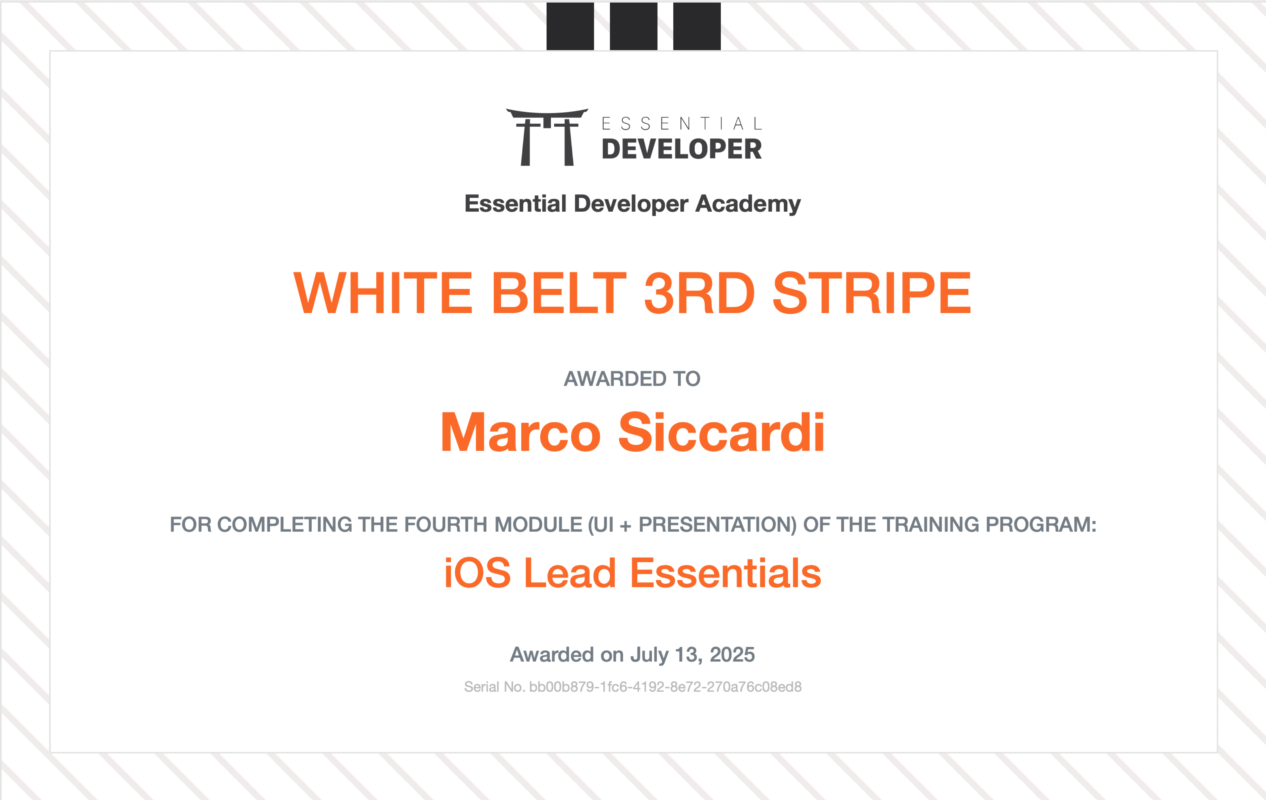Lead Essentials: UI + Presentation Module finished (White Belt 3rd stripe)
It’s time for another update on my journey through the iOS Lead Essentials program. The course continues to challenge and shape the way I approach app architecture and development. With the recent completion of the fourth module, I’ve now achieved the White Belt 3rd stripe — and with it, gained a deeper understanding of building clean and testable UI and Presentation layers in Swift.
This module was all about the interface between users and our code: how data is presented on screen, how user input is handled, and how to structure this part of an app in a scalable, testable, and maintainable way.
Understanding UI, UX, and Presentation Responsibilities
We started with fundamentals: what makes good UI and UX, how to structure the presentation layer for testability, and how to collaborate effectively with designers. While some of this was familiar territory, the practical tips on validating UI design through fast prototyping, and getting early feedback before investing too much time, were immediately useful.
Another highlight was refining how we load and present data efficiently — especially images, which can be a major performance bottleneck if handled poorly. I learned how to prefetch images as cells become visible, cancel unnecessary requests to reduce data usage, and apply these strategies using reusable UI components.
From MVC to MVVM and MVP — and Beyond
This module also dove deep into architectural patterns. We revisited MVC, looking at both best practices and common pitfalls — particularly the infamous Massive View Controller problem. The course offered strategies for breaking down complex scenes using smaller, collaborative MVCs.
From there, we moved on to MVVM and MVP, each with their own strengths and common misuses. Identifying massive view models or presenters was eye-opening, as was the idea of combining both patterns with platform-agnostic components. The hands-on approach of test-driving each pattern in Swift gave me clarity on how and when to apply them. I also learned to implement both stateful and stateless view models — something I hadn’t used to my advantage before.
Making the Most of Xcode and Swift
The course didn’t stop at patterns. I spent time learning how to organize my codebase for reuse across platforms. By separating platform-specific and platform-agnostic code using Swift frameworks in Xcode, and learning how to properly support multiple platforms.
Retain cycles can silently harm app performance, so learning how to spot and eliminate them using the Proxy design pattern was another valuable lesson. Similarly, I learned more about the Adapter and Decorator patterns and saw how they can help bridge incompatible components or extend object behavior in a clean, testable way.
Testing and Refactoring with Confidence
Throughout the module, there was a strong emphasis on maintaining high-quality, testable code. I explored both inside-out and outside-in development strategies, and how Swift’s type system and compiler can back up safe refactorings. I also learned how to safely add tests to legacy code — something every long-running project eventually needs.
Finally, the module wrapped up with techniques for creating reusable components using generics in Swift, and the importance of test-driving localized strings to ensure customer-facing features work as expected in every supported language.
What’s Next?
I’ll continue progressing through the remaining belt levels in the Lead Essentials curriculum. The journey so far has already leveled up my thinking as a developer, and I’m looking forward to level up further as the course progresses.
Click to see the full iOS Lead Essentials curriculum
Disclaimer: This blog post was written with the help of AI, based on a bulleted summary of learning topics provided as part of the Lead Essentials program. The structured list served as the foundation for turning the content into a more readable, narrative-style post that reflects my personal learning experience. I reviewed and edited the post before publishing to ensure it meets the quality standards of this blog.
